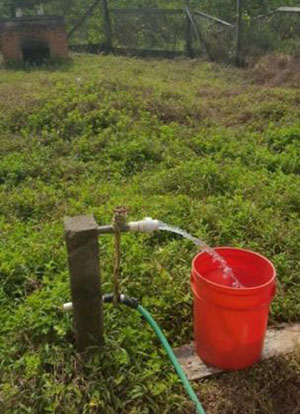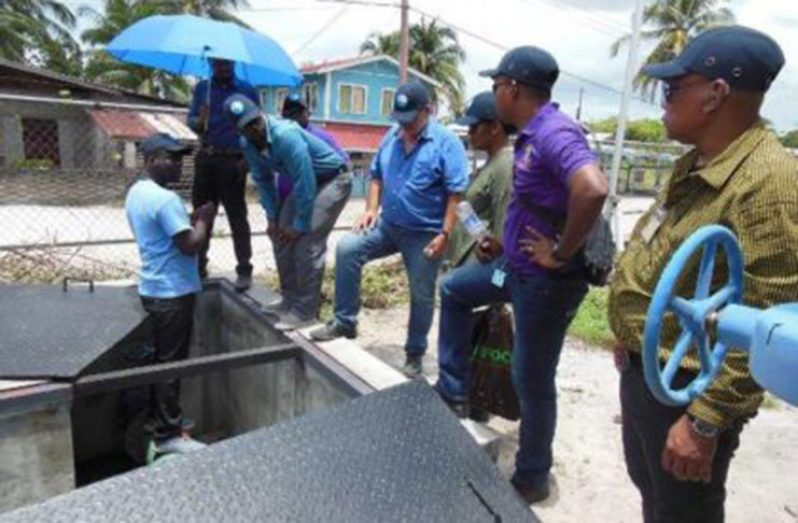STEADFAST and committed to providing potable water to citizens, the Government expended approximately two billion dollars in 2016 to improve and expand access to water.

Given the investment, the following outputs have been achieved, according to Minister within the Ministry of Communities, Dawn Hasting-Williams, who has responsibility for the water sector: In 2016, residents in more than 43 communities received water for the first time, and more than 45,300 people benefited directly. This intervention also significantly reduced the risk of contracting water-borne diseases.
Moreover, beneficiaries saved considerable amounts of time and money previously spent on buying and transporting water for their daily domestic use.
Residents of ‘D’ and ‘E’ Fields, Sophia are among those who can now boast of having access to water through their taps in their homes for the first time in many years. The project entailed the extension of transmission lines to Sophia from newly rehabilitated wells in North Ruimveldt and Turkeyen. More than 20,000 residents are benefiting from the completion of works.
COASTAL WATER PROGRAMME
The sum of $585 million was expended under the Coastal Water Programme in 2016. The many outputs that have been achieved include the installation of transmission mains and expansion of distribution network at Kuru Kururu.
According to Minister Hastings-Williams, prior to this intervention, the residents were, on a daily basis, saddled with high costs to procure and transport water for their daily use. Approximately 500 persons have benefited from this improved level of service.
There was also the installation of water supply system at Waikabra, Soesdyke. Minister Hastings-Williams said that prior to the intervention, residents were using water from a nearby creek. Approximately 1000 residents are now benefiting from newly installed pipes and a new well.
Completion of the distribution network in Friendship Squatting Area has benefited more than 1,250 residents. Prior to this intervention, the residents’ only source of water was rain. According to Minister Hastings-Williams, during the dry season, these residents had to seek alternative sources, which exposed them to water-borne diseases. The residents can now receive potable water for the first time at a level of service of four metres.
Also under the Coastal Water Programme, there was the drilling of a new well and installation of transmission and distribution lines at Lima Sands Housing Scheme in Region Two. This project has benefited approximately 1,000 persons. Prior to the intervention, residents were using water from the nearby creek.
URBAN WATER
Under the Urban Water Programme, the 2016 budgeted amount of $226.1 million was expended to achieve the following: the supply and installation of distribution mains and service connection upgrade in Lamaha Park; along Duncan Street, Campbell Avenue and Durey Lane, benefiting more than 8,000 residents. Residents from these areas now have access to a high level of water service for the first time in 10 years.
Meanwhile, the replacement of a distribution main at Meadow Bank has benefited approximately 350 households.
Under the Hinterland Water Programme, $178.4 million were expended. Residents of Monkey Mountain, Region 8, now have access to potable water supply for the first time. This intervention has precluded them the arduous task of walking long distances to access potable water. Over 750 residents have benefited from this intervention.
Also under this programme, 2016 saw improved access to potable water in Campbelltown, Region 8. Residents in this village as well as in Mahdia can now access potable water even if there is drought. This project has benefited more than 600 persons.
Further, the hospital in Mahdia is now receiving safe water. Also benefiting from improved access to potable water in 2016 were the residents of Princeville, Region 8. Prior to this intervention, residents used to walk long distances to access potable water, or rely on rain water harvesting. More than 2,000 persons from this community can now access potable water for the first time.
Another plausible output of the Hinterland Water Programme which will be realised shortly is the installation of mains and reconfiguration of systems at Paramakatoi. Not only will this project bring relief to the poor in terms of access to water, but it will add to the village’s economy, since the laying of pipes will be done by residents.
Residents in Mahdia, Port Kaituma, Koko, Moruca, Mabaruma, Tassarene and Karrau have been among others that benefited in 2016 from improved water supply under the Hinterland Water Programme.
The Guyana Water Incorporated (GWI) has responded to a diarrhoeal outbreak in Region 7. A team of GWI officials distributed 17 lifesaver filters to the Karrau and River’s View villages where reports of the outbreak were more prevalent.
GWI also deployed two engineers to Arakaka, Region One to address the lack of water supply there, caused by cloud cover over the photovoltaic system in the community.
LINDEN WATER PROGRAMME
Under the Linden Water Programme, a budgeted amount of $150.2 million has been expended in 2016, and as a result, residents within the mining town have benefited from improved access to potable water by way of decommissioning of old mains, construction of bypass mains, rehabilitation of overhead tanks, and the upgrading of transmission and distribution mains.
LINDEN WATER SUPPLY REHABILITATION PROJECT
Under the Linden Water Supply Rehabilitation Project, $99.4 million were expended instead of the initially allocated amount of $79 million. The increase in expenditure covers rehabilitation of the two water treatment plants, constructed in 2015 under this project at a cost of $1.8 billion.
They had to undergo in 2016 substantial remedial work to the value of $54 million. The newly constructed treatment plants were experiencing operational challenges. To rectify the flaws, GWI had to install additional filter nozzles, air scour system, and protective covering for chemical pumps, among other things.
Further, three mini-laboratories were established at the water treatment plants in West Watooka, Mackenzie and Amelia’s Ward. The aim of this exercise was to monitor more frequently important parameters of water quality, such as pH, turbidity, colour, metals, and chlorine residual and microbial contamination. The laboratories were equipped with the essential monitoring equipment and requisite reagents to monitor the water quality round-the-clock.
Under the Linden Water Supply Rehabilitation Project, as part of an effort to continuously improve the flow of potable water to residents, there was also the rehabilitation of the Mackenzie and West Watooka treatment plants, done at a combined cost of $49 million.
During 2016, the GWI hosted a number of training programmes as part of efforts to improve its overall service to customers. Staff underwent training in areas such as team building and telephone etiquette, and on water quality improvement. The latter was facilitated by experts from the ‘World is our Water Foundation’ out of Holland. (GINA)




.jpg)









